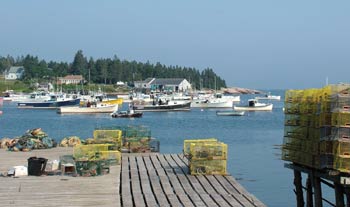Lobster Nation
Impact to Image at St. John
by Laurie Schreiber
|
The lobster industry in an era of global climate change was a dominant topic of conversation at the fourth Canadian/U.S. Lobstermen’s Town Meeting. The meeting-hosted by the Lobster Institute in Orono and held last April in St. John, New Brunswick, Canada—drew about 65 people, coming from as far south as Florida and as far north as Nova Scotia.
“If there is going to be some carbon tax or some future cost associated with greenhouse gases, it’s going to take an industry-wide effort to minimize carbon emissions,” said John Driscoll, a master’s candidate at Dalhousie University in Halifax, who is working on a “life cycle assessment” of the Maine lobster fishery, including an economic component dealing with carbon energy outputs. The assessment is examining hot spots of environmental energy in the fishery, and will result in a model of all the energy and material that goes into lobster fishing and related industry sectors—from the fishermen, through the dealers and shippers, to the consumer. As the issues of global climate change become more apparent, people are becoming more concerned, and the lobster industry, like all other industries, will have to adjust, Driscoll said.
“The key thing to be thinking about here is that, if there is some kind of carbon tax or some kind of cost associated with greenhouse gases, it is going to be based on the carbon emitted through the entire chain,” Driscoll said. “While fishing is certainly an important part of the production chain, you have to look at all of the other aspects of it.
continue
|

Traditional or not, the economic and social forces at play in driving the fishery are far more complex these days. Prices are at historical highs, but fishermen said they aren’t making any money due to the high cost of doing business. It was agreed that few fishermen understood what was driving the prices that consumers pay. Some said they feel there is a “disconnect” in what they as fishermen receive for a boat price, and what they see being paid by consumers. Fishermen's Voice photo |
|
|
|
|
Earnest Libby, Jr.: See Other Side
by Mike Crowe
|
There have been an awful lot of boatbuilders over the years on Beals Island off Jonesport. In the 1950s and 60s there were 11 boat shops on an island with a population of 500. The Jonesport boat, the local traditional lobster boat built at Beals and Jonesport into the 1960s, has a distinct style. With a narrow beam, skeg built, sheer low to the water, tumblehome in the stern, low cabin trunks occasionally with diamond shaped windows in them, they stand out.
Historically fishing boats have been designed by fishermen or fishing boatbuilders, not marine architecture firms. In the days of sail, architects took lines off fishing boats to design yachts for recreational racing. Fishermen builders made design changes above and below the water that in some cases became regional styles. The Jonesporter is an easily identified example.
continue
|
| Ernest in his shop in 1969 working on the stern frame of the Marguerite G. In the background is a boat he was building for Ossie Beal. Fishermen's Voice file photo |
|
|

